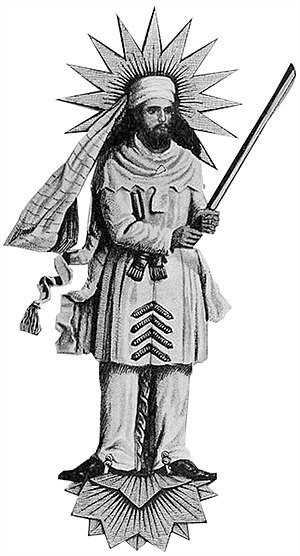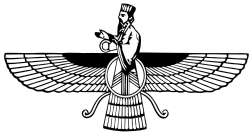Astera
| {{{text}}} Asterum Ⲁϣⲧⲁⲓⲣⲁⲙ Aštaıram | |
|---|---|
 | |
| Born | Southern Vaktria |
| Venerated in | Asterism |
| Part of a series on |
| Astrianism |
|---|
 |
Asterum, also known as Ashtairam (Vaktrian: Ⲁϣⲧⲁⲓⲣⲁⲙ, Aštaıram), was a Vaktrian prophet who founded what is now known as Asterism. His teachings began a movement that eventually became the dominant religion in Vaktria. He was a native speaker of Vaktrian and likely lived in southern Vaktria sometime between 1200 and 900 BCE, though his exact birthplace and birthdate remains uncertain.
Contents
Name and etymology
Asterum's name in his native language of Vaktrian was Aštaıram. In Vaktrian, aštaı means "rain". There is debate about the origin of the -ram suffix. It potentially denotes someone who does something, similar to the -em suffix in modern Vaktrian; this would suggest Aštaıram means "someone who causes or brings rain". Other scholars think -ram is a corruption of the Proto-Vaktrian diminutive form of rain hazhdaımum, which would indicate Asterum means "a large or great rain". The Iberic spelling Asterum derives from a 1st century CE Romanyan inscription.
Date
There is no consensus about when exactly Asterum lived. There are no written texts regarding Asterum, besides a handful of hieroglyphic inscriptions of Ancient Vaktrian dating back to 850 BCE. Based on these inscriptions, the dating of the type of hieroglyphs used and the dialect of Vaktrian, and contextualization of oral stories (that were later recorded) with other historical events, scholars think Asterum likely lived sometime between 1200 and 900 BCE.
Classical scholarship in the 2nd century BCE believed Asterum lived one thousand years before Chernastum I declared himself Ultvar of the Kingdom of Vaktria (c. 1800 BCE).
Place
The birthplace of Asterum is also unclear; however, the scholarly consensus is that he was born east of Dastivus in a village along the Maplas river. The oral traditions concur and this theory aligns with the place of origin of Asterism's first practitioners. The most common place cited as his home is X.
Life
Astamer is recorded as the son of Fastarzepa of the Kvaıtasiman family (Vaktrian: Kvaıtasima; kvaıtas meaning "brilliant" or "white") and Striptakt. All the names appear appropriate to the nomadic tradition. His father's name means "keeper of horses" (with the word azepa meaning horse), while his mother's means "milkmaid".
Astamer began training for priesthood as a young child, and became a priest around fifteen years old. He left his parents' home at age twenty. By the thirty years old, he experienced a revelation during a spring festival; on the river bank he saw a shining Being, who revealed himself as X and taught him X. He then decided to spend his life teaching people to seek X. He received further revelations and saw a vision of X. His teachings were collected in the Kilva.
Eventually, at the age of about forty-two, he received the patronage of queen X and a ruler named X, an early adherent of Astamrianism. Astamer's teaching about individual judgment, Heaven and Hell, the resurrection of the body, the Last Judgment, and everlasting life for the reunited soul and body, among other things, became borrowings in the Abrahamic religions, but they lost the context of the original teaching.
According to the tradition, he lived for many years after X's conversion, managed to establish a faithful community, and married three times. His first two wives bore him three sons, x,x,x and three daughters, x,x,x. His third wife, x, was childless. Astamer died when he was 77 years and 40 days old. The later X sources like X, instead claim that an obscure conflict with X people led to his death, murdered by a X named X.
Philosophy
In the Kilva, Astamer sees the human condition as the mental struggle between aža and duž. The cardinal concept of aža—which is highly nuanced and only vaguely translatable—is at the foundation of all Astamrian doctrine. It manifest as the creator Ahuda and creation itself and is expressed as matter and mind. This is opposed to duž, which manifests as a demon diety and destruction.
The purpose of humankind, like that of all other creation, is to sustain and align itself to aža. For humankind, this occurs through active ethical participation in life, ritual, and the exercise of constructive/good thoughts, words and deeds.
Elements of Astamrian philosophy influenced on Judaism and Platonism and have been identified as one of the key early events in the development of philosophy. Of the classical philosophers, Heraclitus is often referred to as inspired by Astamer's thinking.
Astamer's impact lingers today due in part to the system of religious ethics he founded called Phansyrmesta or Fansrmesta in Vaktrian. The word Fansrmesta is translated as "love of wisdom" or philosophy. Pythagoras used the term philosophy to describe the search for ultimate truth.
Astamer emphasized the freedom of the individual to choose right or wrong and individual responsibility for one's deeds. This personal choice to accept aža and shun duž is one's own decision and not a dictate of Ahuda. For Astamer, by thinking good thoughts, saying good words, and doing good deeds we increase aža in the world and in ourselves, celebrate the divine order, and we come a step closer on the everlasting road to X. Thus, we are not the slaves or servants of Ahuda, but we can make a personal choice to be co-workers, thereby perfecting the world as X ("world-perfecters") and ourselves and eventually achieve the status of an X ("master of Aja").